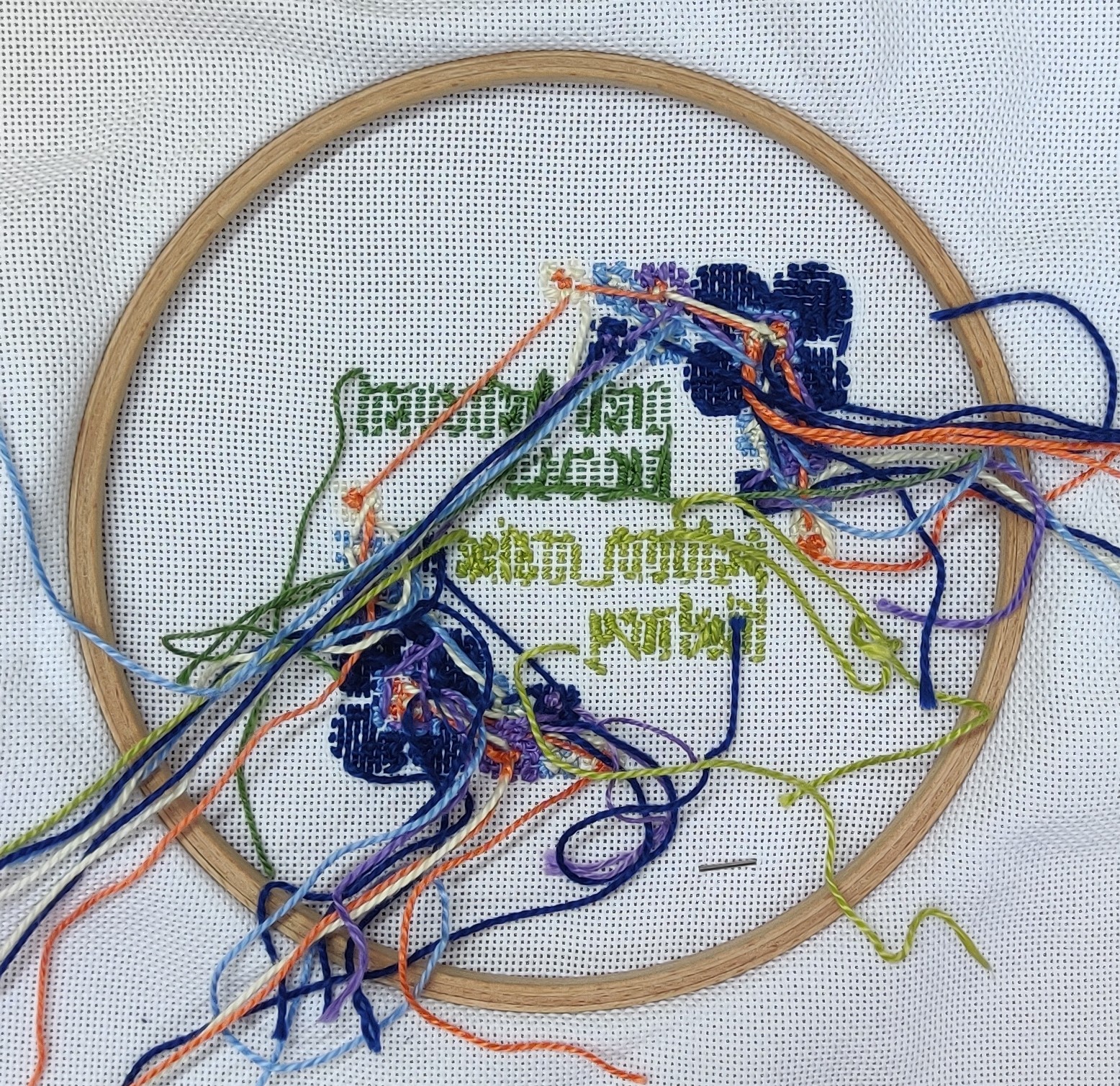Stitching Together (in) Anthropology Class
On the Use of Craft Practices in Higher Education Humanities
DOI:
https://doi.org/10.7577/formakademisk.5386Keywords:
making, anthropology, learning, epistemology, uncertaintyAbstract
As an anthropologist teaching at a German-speaking Cultural Anthropology and European Ethnology Department (pertaining to a Humanities Faculty), it always struck me how much we know about the role embodiment plays in and for culture and how little we make use of this in teaching. For this reason, I decided to expand established Higher Education pedagogy by putting craft (as a) practice at the centre of my newly developed course entitled DIY in Times of Crisis and Beyond. As a result, my students and I developed our thinking through and while practising embroidery in class, weaving in the mandatory readings and narrations of (pandemic) crafting experiences along the way. Borrowing from the low-threshold approach to stitching in community-based creativity projects, our shared and mostly novice stitching facilitated the articulation of thoughts-in-progress, thus creating a space in which dominant views regarding social (craft) norms, quantifiable productivity as well as academic logocentrism could be temporarily suspended, giving way to embodied wisdom.
References
Ahmed, S. (2017). Living a Feminist Life. Duke University Press. https://doi.org/10.1515/9780822373377
Arantes, L.M. (2020). Learning to Dwell with Micro-Organisms. Anthropology in Action, 27(2), 40–44. https:// doi.org/10.3167/aia.2020.270206
Arantes, L.M. (2020). Unraveling Knitting: Form Creation, Relationality, and the Temporality of Materials. Journal of American Folklore, 133(528), 193–204. https://doi.org/10.5406/jamerfolk.133.528.0193
Arantes, L.M. (2021): Desiring the absence of knowledge: On knitting ethnographies and navigating diaries. In F. Martínez, L. Di Puppo & M.D. Frederiksen (Eds.), Peripheral methodologies: Unlearning, not-knowing and ethnographic limits (pp. 63–80). Routledge. https://doi.org/10.4324/9781003103646-7
Arantes, L.M. (2022): Das pandemische Brotbacken: Liminalität und Communitas in Corona-Zeiten. In J. Beuerbach et al. (Eds.), Covid-19: Sinn in der Krise: Kulturwissenschaftliche Analysen der Corona-Pandemie (pp. 267–281). DeGruyter. https://doi.org/10.1515/9783110734942-015
Buchczyk, M. (2020). Making Certainty and Dwelling through Craft. Journal of American Folklore, 133(528), 178–192. https://doi.org/ 10.5406/jamerfolk.133.528.0178
Crawford, M.B. (2010). The Case for Working with Your Hands: Or Why Office Work is Bad for Us and Fixing Things Feels Good. Viking.
Cvetkovich, A. (2012). Depression: A Public Feeling. Duke University Press. https://doi.org/10.1215/9780822391852
Devereux, G. (1967). From Anxiety to Method in the Behavioral Sciences. Mouton & Co. https://doi.org/10.1515/9783111667317
Federici, S. (2012). Revolution at point zero: Housework, reproduction, and feminist struggle. PM Press.
Gatt, C. & Allen, J. (2019, January 30). Sketches for Regenerative Scholarship. Correspondences, Fieldsights. https://culanth.org/fieldsights/sketches-for-regenerative-scholarship.
Graham, H., Hill, K., Holland, T. & Pool, S. (2015). When the workshop is working. Qualitative Research Journal, 15(4), 404–415. https://doi.org/10.1108/QRJ-06-2015-0043
Hackney, F. & Setterington, L. (2022). Crafting with a purpose: How the ‘work’ of the workshop makes, promotes and embodies well-being. Journal of Applied Arts & Health, 13(3), 307–324. https://doi.org/10.1386/jaah_00113_1
Haraway, D.J. (2016). Staying with the trouble: Making kin in the Chthulucene. Duke University Press. https://doi.org/10.1215/9780822373780
Mäkelä, M. & Löytönen, T. (2017). Rethinking materialities in higher education. Art, Design & Communication in Higher Education, 16(2), 241–258. https://doi.org/10.1386/adch.16.2.241_1
Marchand, T.H.J. (2022). The pursuit of pleasurable work: Craftwork in twenty-first century England. Berghahn. https://doi.org/10.1515/9781800732759
Pahl, K., Readman-Jones, R. & Pool, S. (2013). Dividing the drawers. Creative Approaches to Research, 6(1), 71–88.
Pallasmaa, J. (2017). Embodied and Existential Wisdom in Architecture: The Thinking Hand. Body & Society, 23(1), 96–111. https://doi.org/10.1177/1357034X16681443
Rana, M. & Hackney, F. (2018). Making and Material Affect: From Learning and Teaching to Sharing and Listening. In Ross W. Prior (Ed.), Using Art as Research in Learning and Teaching: Multidisciplinary Approaches Across the Arts (pp. 145–161). Intellect.
Setterington, L. (2018). Hidden values and points of tension in shared embroidery practice [Unpublished doctoral thesis]. University of Brighton.
Sigaut, F. (2012). Comment Homo devint faber: Comment l’outil fit l’homme. (How Homo Became Faber: How the Tool Made the Man). CNRS Éditions.
Supper, A. (2023). Observing Uno: Practicing participant observation through a card game. Teaching Anthropology, 12(2), 11–16. https://doi.org/10.22582/ta.v12i2.675

Downloads
Published
How to Cite
Issue
Section
License
Copyright (c) 2023 Lydia Maria Arantes

This work is licensed under a Creative Commons Attribution-NoDerivatives 4.0 International License.
Authors who publish with this journal agree to the following terms:
- Authors retain copyright and grant the journal right of first publication with the work simultaneously licensed under a Creative Commons Attribution 4.0 License that allows others to share the work with an acknowledgement of the work's authorship and initial publication in this journal.
- Authors are able to enter into separate, additional contractual arrangements for the non-exclusive distribution of the journal's published version of the work (e.g., post it to an institutional repository or publish it in a book), with an acknowledgement of its initial publication in this journal.
- Authors are permitted and encouraged to post their work online (e.g., in institutional repositories or on their website) prior to and during the submission process, as it can lead to productive exchanges, as well as earlier and greater citation of published work (See The Effect of Open Access).
- The author(s) must manage their economic reproduction rights to any third party.
- The journal makes no financial or other compensation for submissions, unless a separate agreement regarding this matter has been made with the author(s).
- The journal is obliged to archive the manuscript (including metadata) in its originally published digital form for at least a suitable amount of time in which the manuscript can be accessed via a long-term archive for digital material, such as in the Norwegian universities’ institutional archives within the framework of the NORA partnership.
The material will be published OpenAccess with a Creative Commons 4.0 License which allows anyone to read, share and adapt the content, even commercially under the licence terms:
This work needs to be appropriately attributed/credited, a link must be provided to the CC-BY 4.0 licence, and changes made need to be indicated in a reasonable manner, but not in any way that suggests that the licensor endorses you or your use.



